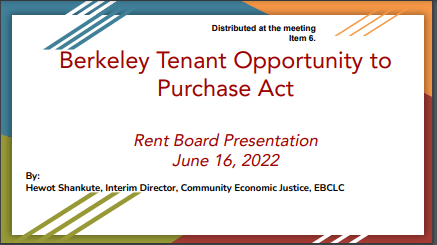Inspired by COPA in San Francisco, there is a spreading movement to catapult renters to the status of homeowners with nonprofits becoming their guardian angels and brokering deals.

There has been a steady erosion of owner rights and growing disfavor when a landlord does not use their properties for the greater public good, as we submitted in an earlier article on Robin Hood-like policies. This sentiment continues, and if properties are not employed for the benefit of all, there is a price to pay.
![]()
We keep thinking about Barry Manilow’s Copacabana song when policies first came about to give tenants and nonprofits first dibs on properties when they go up for sale. First, we had COPA, then TOPA, and now OPA.
Besides having a nice rhyme to them, the common denominator with these programs is the goal of empowering tenants with options to have an ownership stake in the property they rent.
Chances are that the tenants themselves do not have the wherewithal to buy the property. Even if residents organize and attempt to negotiate a contract, it’s unlikely that these renters will be able to pool their funds and collectively fork over six or seven figures to purchase the property.
That’s when a nonprofit dedicated to affordable housing can swoop in to have the right to make the first offer to purchase the property and match or beat any subsequent offer made by buyers on the private market.
East Palo Alto is the latest locale in the Bay Area to experiment with this by inking the Opportunity to Purchase Act.
![]()
There are detractors.
In an opinion piece, then-East Palo Alto Councilmember and now Vice Mayer Antonio Lopez says it is a social riddle to house everyone in Silicon Valley, one of the richest places in the world.
After all, a technology hub needs to accommodate not only high-paid engineers and programmers, but cafeteria workers, shuttle drivers, and security guards, among other workers.

Lopez emphatically said at the time that he is a progressive and has a deep commitment to helping tenants achieve the dream of homeownership, but that he’s also a realist. He doubted that renters could afford to own properties going for millions of dollars and pointed out that the city didn’t have the fiscal capacity to take on any substantial role in acquiring properties.
Instead, nonprofits would likely become the main players in real estate transactions, he said, essentially becoming real estate brokers. He went on to say that this role is concerning, even for the leadership of these organizations.
It was brought to our attention that the Vice Mayor may have changed his tune at this late date. We've reached out to his office but did not immediately receive a response.
Industry partners have expressed their concerns. They are multifold.
Our friends at the East Bay Rental Housing Association give a scathing assessment of these types of programs.
-
Would-be buyers may be reluctant to make an offer on a multifamily property knowing that a qualified nonprofit has a right of first refusal.
-
With the competitive advantage nonprofits have by reviewing properties that are unlisted, unpublished, and unknown, sellers may lose motivated private buyers.
-
Sellers involved in a 1031 exchange or those settling an estate may not be able to adhere to the required timeframes.
-
Potential investors who would otherwise be interested in multifamily properties may decide that there is too much hassle with the thicket of regulations and divert their investment dollars elsewhere.
-
The government should have no business telling owners to whom they should sell their properties.
-
An erosion of city revenue in the form of business, property, and transfer taxes. The cost of the program will be on the backs of taxpayers.
-
Displacement of immigrant communities and communities of color, with generational financial and economic stability at risk, as well.
As if these reasons are not compelling enough to oppose the spread of these initiatives, a grassroots effort by EBRHA has been launched to point out flaws in TOPA and similar measures, with a website laying out more arguments against these policies at https://www.ebrha.com/topa.
![]()
We’ll add that in San Francisco, deed restrictions will be placed on the building and so once the multifamily building is sold, it becomes rent-restricted housing in perpetuity. The new landlord will not be able to set rents that exceed 80% of the Area Median Income, a fluctuating metric set by the Planning Department.
As for the point of government intrusion, we’ll admit when we are wrong. Back when San Francisco was vetting nonprofits and tinkering with its rules surrounding the Community Opportunity to Purchase Act, we thought that the whole notion that the city can dictate to owners to whom they can sell their property would be challenged in court. So far, we are unaware of any litigation challenging COPA. We surmise that this is because the initiative did not have much of an impact.

What we were right about was that there would be an oligopoly in San Francisco, with only a small number of nonprofits able to come to the trough.
At least one forward-thinking enterprising follower told us that he intended to start a nonprofit organization to get the privilege of discovering multifamily properties before they were offered to traditional buyers. We had to correct him by saying it is an exclusive club and that only nonprofits with a history of managing affordable properties would be in the good graces of the city.
Another one of our predictions came to pass: with their charter to do the most good for the masses, nonprofits would make offers on larger buildings and overlook smaller rental properties.
Although the ordinance says that properties with 3+ units are fair game, this housing stock is considered too small to be gobbled up by organizations.
It turns out that while some feared that these types of initiatives to identify properties up for sale and somehow use them for the greater public good did not put much of a dent in the dearth of affordable housing, and nonprofits are not chomping at the bit to scoop up properties. COPA turned out to be a nothing burger.
We have not checked in with the San Francisco Mayor’s Office of Housing and Community Development to see how many rental units have been taken under the care and control of nonprofits thus far, but we did come across this KQED article published on March 9th that stated that nonprofits preserved only 15 buildings containing 230 permanently affordable apartments. Keep in mind it has been five years since COPA took effect.
When it comes down to basics, nonprofits only have an appetite for bigger buildings. Still, smaller landlords must comply with regulations.
Arbitraging the ordinance?
When eyeing multifamily properties soon to be advertised for sale, the current roster of nonprofit organizations will act in good faith by paying attention only to those buildings in which they have a genuine interest.
Down the road, however, what if more opportunistic nonprofits sprout up and they want a glimpse into all of the properties up for sale whether or not there is any real desire to buy a particular property? When a nonprofit uses its insider access to hold up the sale of a property just because it can, it is not right. In an earlier webinar, we touched on this.
It’s been said that all politics are local, but some are more local than others. If big, bold initiatives cannot pass in Sacramento, the fight will be taken to local governments, and this is what we are seeing.
We’ve seen this repeatedly. Whether there are failed efforts to take a jab at Costa-Hawkins, water down the statewide eviction and rent controls spelled out in AB-1482, create a statewide rent registry, or other lofty items on the agenda of tenants’ advocates, the wish list of tenants’ advocates inevitably seeps down to municipalities and rent boards.
AB 919 is a case in point. Coined the Stable Homes Act, its author, Assemblymember Ash Kalra of San Jose, would have given tenants, local public agencies, and mission-driven nonprofits statewide the first opportunity to purchase or match an offer on rental properties when owners decide to put them up for sale. This measure died on the vine this past spring, but it did not deter activists from pushing for initiatives on the local level. If this crackpot policy cannot pass in Sacramento, it could, nevertheless, sail through in places like East Palo Alto, where on Tuesday, November 7, over 70 people spoke at the City Council meeting.
Most of the community members in attendance opposed OPA, but there was a cohort of nonprofits that sang hymns for the measure, falsely stating that TOPA was alive and well in Berkeley, even though the measure had failed several times.
There are rumors, however, that these policies will metastasize to Berkeley and Oakland. This is a game of follow the follower; whenever a Bay Area locale adopts a new law, others are watching closely and come up with a similar measure, if not a carbon copy.
Here’s what Berkeley’s iteration of TOPA might look like »
San Jose, meanwhile, has done its own soul-searching about implementing COPA. The City Council rejected a proposal floated by the Housing Department, but there is no reason to believe this will not be reincarnated in some form or fashion.
Some informed advice and how Bornstein Law can assist
We have said that facets of law have become very specialized and there are many nuances in different rent-controlled jurisdictions. When it comes to landlord-tenant law, not all attorneys are created equal.
In the same vein, not all real estate brokers and agents are familiar with the rigamarole of going back and forth between nonprofits and following procedural requirements of COPA, TOPA, OPA, or whatever else it’s called. Our strong advice is to find a real estate professional who has a working knowledge of the law and has a robust legal background.
Bornstein Law can notify a qualified nonprofit of the owner's intention to put the multiunit property on the open market and with prescribed timeframe windows, we can track the timing of responses, if any.
Our firm can also handle communication between multiple parties and serve as the conduit between nonprofits, private buyers, and sellers. In the event a qualified nonprofit provides an offer, we can prepare a right of refusal and finally, show relevant agencies that the seller is in compliance with applicable law.
A cautionary note to buyers
For buyers who have eyed multifamily properties, have done their due diligence, and are ready to move forward with a purchase, there is another I to be dotted or T crossed. Has the seller complied with applicable rules in whatever regulatory regime that gives deference to nonprofits?
As a private buyer, you want to ensure that the seller did not cut any corners. It would be ideal if there were a contingency included that the seller had fulfilled their obligations and that qualified nonprofits had their fair shake at the multifamily property.
While it should be clear that there is liability for the seller who circumvents the law and ignores nonprofits just because they don’t want to be bothered with the red tape and delays, buyers should understand that they face consequences, as well.
Parting thoughts
Modeled after similar measures in high-cost urban areas like Washington, D.C., San Francisco was a pioneer in California by inking COPA, but this is no longer an experiment. With East Palo Alto enacting its own version of a law designed to preserve affordable housing, this movement is gaining steam. The BART train has left the station.
Our community needs to be aware of it, get acclimated to the rules, and seek legal guidance to navigate what we believe will be yet another set of regulations we think will spread like wildfire.

